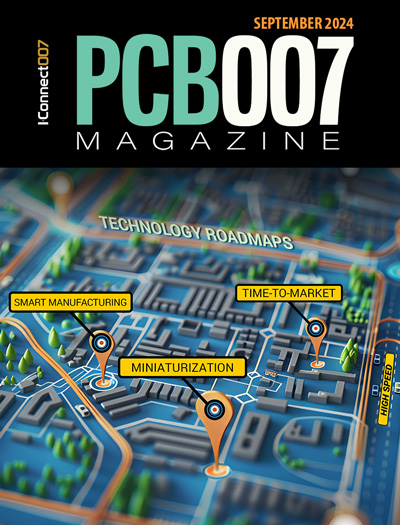-

- News
- Books
Featured Books
- pcb007 Magazine
Latest Issues
Current Issue
Engineering Economics
The real cost to manufacture a PCB encompasses everything that goes into making the product: the materials and other value-added supplies, machine and personnel costs, and most importantly, your quality. A hard look at real costs seems wholly appropriate.

Alternate Metallization Processes
Traditional electroless copper and electroless copper immersion gold have been primary PCB plating methods for decades. But alternative plating metals and processes have been introduced over the past few years as miniaturization and advanced packaging continue to develop.

Technology Roadmaps
In this issue of PCB007 Magazine, we discuss technology roadmaps and what they mean for our businesses, providing context to the all-important question: What is my company’s technology roadmap?
- Articles
- Columns
Search Console
- Links
- Media kit
||| MENU - pcb007 Magazine
A Paperlike LCD -- Thin, Flexible, Tough and Cheap
March 29, 2018 | AIP.orgEstimated reading time: 2 minutes
Optoelectronic engineers in China and Hong Kong have manufactured a special type of liquid crystal display (LCD) that is paper-thin, flexible, light and tough. With this, a daily newspaper could be uploaded onto a flexible paperlike display that could be updated as fast as the news cycles. It sounds like something from the future, but scientists estimate it will be cheap to produce, perhaps only costing $5 for a 5-inch screen. The new optically rewritable LCD design was reported this week in Applied Physics Letters, from AIP Publishing.
The team focused on two key innovations for achieving highly flexible designs. The first is the recent development of optically rewritable LCDs. Like conventional LCD displays, the display is structured like a sandwich, with a liquid crystal filling between two plates. Unlike conventional liquid crystals where electrical connections on the plates create the fields required to switch individual pixels from light to dark, optically rewritable LCDs coat the plates with special molecules that realign in the presence of polarized light and switch the pixels. This removes the need for traditional electrodes, reduces the structure’s bulk and allows more choices in the type and thickness of plates. Consequently, optically rewritable LCDs are thinner than traditional LCDs, at less than half a millimeter thick, can be made from flexible plastic, and weigh only a few grams. “It’s only a little thicker than paper,” said Jiatong Sun, a co-author from Donghua University in China.
Optically rewritable LCDs are durable and cheap to manufacture because of their simple structure. Moreover, like an electronic paper screen in an e-book, energy is only required to switch display images or text. Therefore, running costs are low because these new LCDs don’t need power to sustain an image once it is written on the screen.
The second innovation involves the spacers that create the separation of the plastic or glass plates. “We put spacers between glass layers to keep the liquid crystal layer uniform,” Sun said. Spacers are used in all LCDs to determine the thickness of the liquid crystal. A constant thickness is necessary for good contrast ratio, response time and viewing angle. However, when plates bends, it forces the liquid crystal away from the impact site and leaves sections of the screen blank and so alterations in spacer design are critical to prevent liquid crystal in flexible LCDs from moving excessively. Developing a flexible design that overcomes this barrier has proven challenging.
The researchers tried three different spacer designs and found that a meshlike spacer prevented liquid crystal from flowing when their LCD was bent or hit. This innovation enabled them to create the first flexible optically rewritable LCD.
An additional innovation involved improved color rendering. The scientists report that until this study, optically rewritable LCDs had only been able to display two colors at a time. Now, their optically rewritable LCD simultaneously displays the three primary colors. They achieved this by placing a special type of liquid crystal behind the LCD, which reflected red, blue and green. To make this into a commercial product, Sun wants to improve the resolution of the flexible optically rewritable LCD.
“Now we have three colours but for full colour we need to make the pixels too small for human eyes to see,” Sun said.
Suggested Items
NTT, Olympus Joint Demonstration Shows IOWN APN's Low-latency Capability
11/21/2024 | JCN NewswireNTT Corporation and Olympus Corporation announced that, following the start of their joint experiment in March of the world’s first cloud endoscope system which processes endoscopic videos on the cloud, they jointly established a cloud endoscopy system utilizing the IOWN APN technology.
All Flex Solutions Adds Talent to Flexible Circuit Facilities
11/14/2024 | All Flex SolutionsAll Flex Solutions is excited to welcome John Letourneau as our Director of Facilities and Maintenance at our Flexible Circuit Centers of Excellence!
Flexible Circuit Technologies Announces Major Expansion of Capabilities & Resources
11/13/2024 | CNWFlexible Circuit Technologies (FCT), a global design and value add manufacturer of flexible circuits, heaters, and membrane switches based in Minneapolis, MN, announces the opening of FCT-Huizhou.
CACI Awarded $226 Million Task Order to Provide Expertise to the U.S. Southern Command Operations (USSOUTHCOM)
11/01/2024 | CACI International Inc.CACI International Inc announced that it has been awarded a five-year task order valued at up to $226 million to provide expertise to the U.S. Southern Command Operations (USSOUTHCOM).
CEE PCB to Exhibit at Electronica 2024
10/31/2024 | CEE PCBTom Yang, CEO of CEE PCB, has announced that his company will be exhibiting at this year’s electronica 2024 to be held in Munich, Germany from November 12th through the 15th at the Trade Faire Center Messe München.


